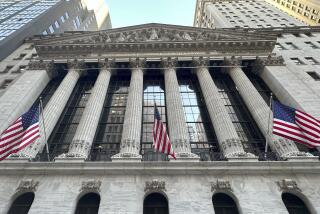Consumer Prices Post Sharp Gain
Prices rose in February at the fastest pace in four months, the government reported Wednesday, in the latest evidence that climbing costs of oil, metals and other commodities are increasingly being passed along to consumers.
With oil prices up, it costs more to make a plastic soda bottle, leading retailers to charge 4% more for a Coke. As fast-growing China hungers for more copper, the pipes and other materials that builders use in U.S. homes grow more expensive.
They were among the factors behind the Labor Department report that said the consumer price index jumped 0.4% in February over the previous month, sharply higher than the 0.1% increase in January.
Core prices, which exclude volatile food and energy costs, grew 0.3%, compared with 0.2% in each of the last four months and the biggest rise since September. Overall prices were up 3% from February 2004, and core prices gained 2.4%, their biggest year-to-year jump since August 2002.
Energy led the increase, leaping 2% for the month and 10.4% for the year. The other biggest increases came in sectors sensitive to the record cost of gasoline, such as transportation and air fares, and in the medical and educational areas, where prices have risen steadily for years.
The report outlining the stronger-than-anticipated inflation came on the heels of Tuesdayâs warning from the Federal Reserve about aggravated inflationary risks.
Analysts said the price gains were worrisome but not fatal to the economic recovery, partly because wages havenât been going up much.
âThe sky is not falling,â said Matthew Martin of Economy.com in West Chester, Pa. âBut itâs getting cloudier.â
Inflation at the consumer level has been largely contained because businesses have spent the last four years steadily absorbing spiraling commodity costs. As the global economy swells, materials such as oil, wool and lumber are subject to a worldwide bidding war. But consumers have been shielded partly because increased competition has forced retailers to keep prices low.
The pain has been born instead by companies like Zaclon Inc. The Cleveland-based company makes chemicals used in the galvanizing process and has seen costs of natural gas, used intensively in its manufacturing, nearly triple since 2001.
Zaclon has passed some of that along to customers, but has absorbed the rest because its clients might go elsewhere.
âWeâre in this herculean effort always to reduce our costs,â Zaclon President James Krimmel said. âIn manufacturing, itâs a global economy. Weâre not a grocery store thatâs competing with a grocery store three blocks away.â
Executives and economists agree that the costs of making products ultimately leak into the marketplace. And in many cases consumers are paying more.
For example, the increased cost of petroleum -- a key ingredient in making plastic bottles -- has upped the cost of making a bottle of Coke by 4% to 5%, estimates Roger van Brugge, who follows the beverage industry for Sanford Bernstein in New York. Coca-Cola Co. has passed that cost along to customers, as has its main rival, PepsiCo Inc.
âItâs the second year in a rowâ the giants have raised prices, Van Brugge said. âI donât think they can pull it off for too many years in a row.â
There are a lot more cost increases lurking, economists say.
John Lonski, chief economist at Moodyâs Investors Service, points out that industrial metal prices have risen an average of 29% annually since 2001. Prices of goods made with those metals havenât seen a comparable jump.
âI think thereâs definitely more [inflation] on the way,â Lonski said.
He pointed out that even though the Fed had raised its benchmark short-term interest rate to 2.75%, that level was virtually the same as the annual rate of inflation.
By keeping rates so low, Lonski said, âthe Fed is making it easier for companies to increase product pricesâ to make up for higher commodity costs.
That should keep profit margins flush. The danger, said Lonski and other analysts, is that if prices keep climbing, workers may be able to extract bigger pay increases. That could kick inflation into overdrive, they fear.
âAs long as you donât get those second-round effects of people going to their employer and saying, âHey, I need more money to pay for the gas in my SUV,â ... I donât think we have an inflationary spiral going on,â said Sheryl King, a senior economist with Merrill Lynch & Co.
For some purchases, such as homes, consumers may not notice rising commodity prices. The cost of steel has doubled in the last year, and cement and lumber costs are also up sharply. âI canât think of one item that has gone down,â said Alan Nevin, chief economist for the California Building Industry Assn.
But the resulting higher cost of building a house is hidden in record home prices, driven up by strong demand.
More to Read
Inside the business of entertainment
The Wide Shot brings you news, analysis and insights on everything from streaming wars to production â and what it all means for the future.
You may occasionally receive promotional content from the Los Angeles Times.










